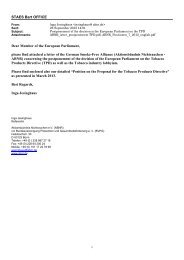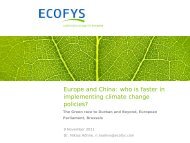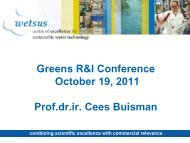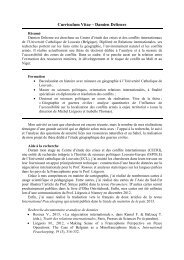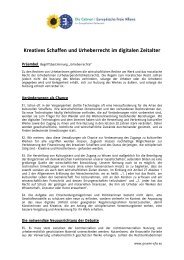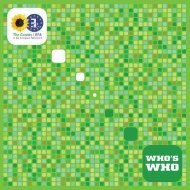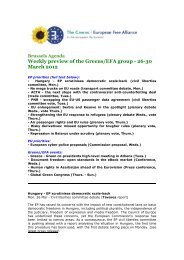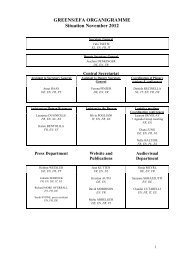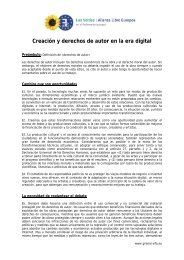Agro-Biotechnology: - The Greens | European Free Alliance
Agro-Biotechnology: - The Greens | European Free Alliance
Agro-Biotechnology: - The Greens | European Free Alliance
You also want an ePaper? Increase the reach of your titles
YUMPU automatically turns print PDFs into web optimized ePapers that Google loves.
Technical development | Cloned farm animals - a ‚killing application‘? | 9<br />
1. Technical development in cloning of farm animals and<br />
its relation to biotechnology applications in livestock<br />
<strong>The</strong> first technology used for cloning in farm animals was the splitting of<br />
embryos, using their specific biological potentials in the early stages of development.<br />
Separated cells from these early stage embryos can be used for producing<br />
additional embryos, in a similar way to how twins emerge naturally from<br />
one fertilised oocyte. This technology only has a limited capacity. In artificial<br />
embryo splitting a maximum of two to four animals can be expected (Gjerris &<br />
Vatja, 2005).<br />
Another technology used to clone farm animals was developed by Willadsen<br />
(1986). He showed that nuclear transfer from embryonic cells into an enucleated<br />
egg cell of the same species can give rise to a whole embryo. This technique<br />
called embryonic cell nuclear transfer (ECNT) also turned out to be of<br />
only minor relevance because, in this case also, the number of embryos that<br />
can be produced from an early stage embryo is limited. But Willadsen (1986)<br />
more or less already established the technology as it was used by Wilmut et al.<br />
(1997) to create Dolly about ten years later.<br />
In 1997 Wilmut et al. published a paper describing the successful transfer<br />
of the nucleus of somatic cells from an adult sheep which became known<br />
as 'Dolly'. This method, the somatic cell nuclear transfer (SCNT), was further<br />
developed and meanwhile successfully applied in more than a dozen mammal<br />
species (sheep, cow, pig, mule, horse, cat, mouse, rabbit, rat, buffalo, ferret, dear,<br />
dog, wolf; FDA, 2008). <strong>The</strong> SCNT meanwhile became a matter of economic relevance<br />
because a number of companies are offering cloned mammals for sale<br />
(pet animals as well as farm animals). Deregulation for food produced from<br />
cloned animals (via SCNT) is under discussion in the US. Most of the issues<br />
discussed in this report refer to the SCNT technology. <strong>The</strong> EGE (2008) defines<br />
SCNT as follows:<br />
“Cloning by somatic cell nuclear transfer (SCNT) involves replacing an egg’s<br />
nucleus with the nucleus of an adult cell (or that derived from an embryo or<br />
foetus) to be cloned, and then activating the egg’s further development without<br />
fertilisation. <strong>The</strong> egg genetically reprogrammes the transferred nucleus, enabling<br />
it to develop directly into a whole new organism.”<br />
<strong>The</strong> 'Dolly procedure' became relevant not only for propagating existing animals,<br />
but also for genetic engineering. A combination of culturing and propagation<br />
of cells from the donor animal together with genetic engineering of the<br />
cells and the selection of the most promising cells is most commonly used.<br />
<strong>The</strong> nucleus of these cells is then transferred into enucleated egg cells. As van<br />
Reenen (2009) explains, SCNT in combination with genetic engineering has<br />
already largely replaced the direct microinjection of new DNA that was used<br />
to produce the first transgenic animals (Hammer et al., 1985), because it can be<br />
more efficient.



